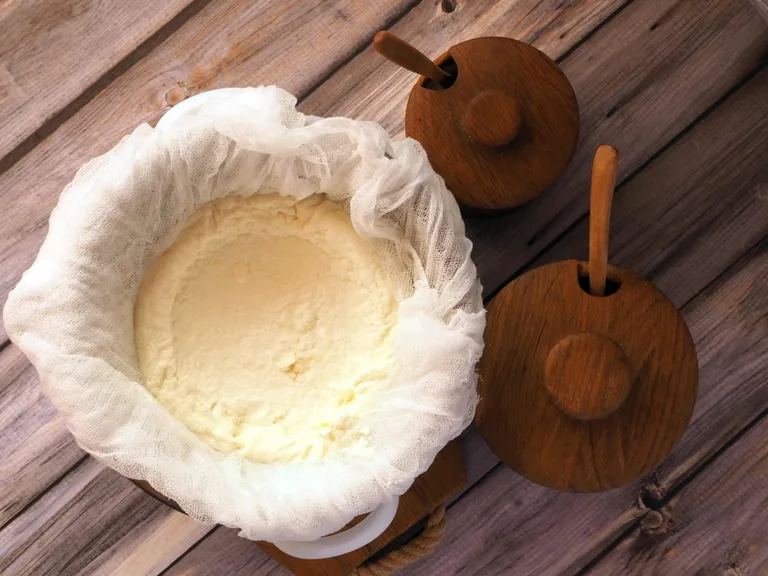What you’ll learn:
- Dry yogurt (yogurt that’s been strained to remove excess liquid, making it thicker, creamier, and higher in protein) is trending on social media, but it isn’t new; many cultures have long enjoyed strained yogurt dishes like labneh and skyr.
- What’s true is that its a great snack because it’s high in protein and probiotics, it won’t cause weight loss on its own.
- Making dry yogurt at home is easy; you just need a strainer or cheesecloth and a little time.
The appeal of a simple food hack that promises quick weight loss continues to drive viral diet trends on social media. We’ve already explored the facts behind rice water and cinnamon water, but the latest buzz is all about dry yogurt, or what some are calling the “dry yogurt bowl.”
Fans claim it’s helped them lose weight, but what exactly is it? Essentially, dry yogurt is super-strained yogurt that resembles soft cheese, sometimes tinted with food coloring for visual appeal.
Is dry yogurt really more satiating or healthier than regular or Greek yogurt? We looked at the science and asked Kayla Reynolds, MS, NASM-CPT, Noom’s Director of Knowledge, Learning & Behavior, to weigh in on whether this trend offers any real advantage for weight loss.
What is dry yogurt?
The term dry yogurt is a name that social media influencers have given to this super-strained yogurt. It’s not “dry” like the name implies, but rather extra-strained to remove most of its liquid whey. This process concentrates the solids, specifically the protein, resulting in a remarkably thick, creamy texture similar to a soft cheese. The concept of dry yogurt isn’t really new, it’s just a rebrand of something cultures around the world have been enjoying for centuries.
Greek yogurt is also strained, but dry yogurt takes it a step further, removing even more liquid for an ultra-thick texture. It’s similar to several traditional foods found around the world:
- Labneh – a soft, tangy cheese made from strained yogurt that’s popular throughout the Middle East.
- Torba – a yogurt-based cheese made from fermented milk, unique to Turkey.
- Skyr – an Icelandic dairy product that’s thick, creamy, and protein-rich, often considered somewhere between yogurt and cheese.
- Chakka – a strained yogurt used in Indian cuisine, typically enjoyed as a base for sweets like shrikhand or as a cooling side dish.
As you can see, “dry yogurt” isn’t new at all; it’s part of a long global tradition of nutrient-dense, milk and yogurt-based foods.
What is a dry yogurt bowl?
A dry yogurt bowl is the trending version of this ancient idea. The thick, super-strained yogurt is shaped or scooped into a bowl and topped with colorful ingredients. The most popular versions feature fresh fruit (like berries or mango), granola, nuts, honey, or a sprinkle of cinnamon, turning this high-protein base into a customizable snack, breakfast, or healthy dessert that’s as photogenic as it is filling.
What does dry yogurt taste like?
Dry yogurt has a tangy, rich flavor and a thick, creamy texture, similar to soft cheese. Its neutral flavor makes it versatile. You can enjoy it as a savory spread (think bagels or veggie dip) or as a sweet treat with fruit, honey, or granola.
How to make dry yogurt at home
The best part? You can easily learn how to make dry yogurt without needing a specialized appliance. All you need is yogurt, a strainer or colander, cheesecloth (or a coffee filter), and a little time.
Here’s a basic recipe for dry yogurt:
- Choose your base: Start with plain Greek or regular yogurt, low-fat or whole-milk, both work. If you prefer flavor, pick a lightly sweetened or fruit variety with minimal added sugar.
- Strain it: Line a sieve or colander with cheesecloth, a coffee filter, or paper towels, and place it over a bowl to catch the liquid whey.
- Add weight: Place a small bowl or plate on top of the yogurt and add a bit of weight (like a can of beans) to help press out the liquid.
- Refrigerate: Set the yogurt in the fridge to keep it cool while it strains.
- Wait: Strain for 8 to 24 hours, depending on how thick you want it—the longer it sits, the “drier” and creamier it becomes.
This simple refrigeration method is sometimes called “drying by straining” and creates a delicious, protein-rich yogurt spread.
Freeze-drying vs. straining
Some viral videos feature “dry yogurt” chips or bark, which are crispy, shelf-stable versions made by freeze-drying or dehydrating yogurt until all the moisture is removed. This process concentrates the flavor and nutrients, creating a crunchy, tangy snack that doesn’t need refrigeration. However, achieving this texture at home usually requires a dehydrator or freeze-dryer, since simply straining yogurt won’t make it dry or crunchy. The traditional straining method is completely different: it creates a fresh, creamy texture you can easily achieve at home with just a strainer and cheesecloth.
Where to buy something like dry yogurt
If you’d rather skip the DIY route, look for labneh in Mediterranean or specialty grocery stores, or check the cheese section of larger supermarkets for similar fresh, strained cheeses like fromage blanc.
Rx weight loss, the right way, with Noom
Get access to prescription weight loss medication with Noom.Dry yogurt and weight loss: What does the science say
“Dry yogurt” might sound like a new wellness trend, but it’s really just super-strained yogurt, similar to labneh, that’s been enjoyed for centuries. What’s new is the attention it’s getting online for potential weight loss benefits. While it’s definitely nutritious, it’s not a miracle food. People love it for its creamy texture and satisfying taste, but its real appeal lies in how it can support a balanced approach to healthy weight management.
Here’s a closer look at the top claims (and what research actually says).
Claim 1: It’s low in calories
Verdict: It depends.
When most of the liquid whey is removed, you’re left with a concentrated mix of protein and fat. That means calories depend on your starting yogurt. Whole-milk versions will be higher, while low-fat or nonfat options will be lighter. For example, ½ cup of labneh made from low-fat yogurt contains roughly 100 to 120 calories and 8 to 10 grams of protein.
Claim 2: It keeps you full longer
Verdict: Maybe.True.
When yogurt is strained, its protein becomes more concentrated, which means it can help keep you feel fuller for longer. In other words, adding higher-protein yogurt, like dry yogurt, to your day may help you stay full between meals. But, but a low-fat Greek yogurt will likely do the same.
Claim 3: It can help you lose weight
Verdict: Not supported.
Dry yogurt can absolutely fit into a weight-loss plan—but it won’t cause weight loss on its own. You lose weight when you create a consistent calorie deficit. That said, if you swap higher-calorie spreads or snacks for low-fat dry yogurt, you can make it easier to stay in that deficit.
“Dry yogurt is high in protein and can help you feel fuller longer,” says Reynolds. “It’s a healthy choice, but real weight loss progress comes from your diet, not any single food.”
Claim 4: It’s good for your gut
Verdict: True.
Yogurt contains probiotics, and the beneficial bacteria remain once the yogurt is strained. Probiotics help support digestion, nutrient absorption, and a balanced microbiome—all of which play a role in gut health and overall well-being.
Claim 5: It’s a smart swap for creamy spreads
Verdict: True.
Dry yogurt’s thick, tangy texture makes it an easy, protein-packed replacement for cream cheese, sour cream, or mayo. It adds creaminess and flavor to dips, dressings, and spreads, often with fewer calories, more protein, and better nutrition.
However, straining does come with a small trade-off—some nutrients are lost in the whey. One study found that strained yogurt can lose about half or more of its thiamin, riboflavin, and potassium during the process.
Subscribe to Noom Digest
With the latest Noom news, insightful articles, and a healthy dose of inspiration, Noom Digest might just become your favorite newsletter.Is dry yogurt safe?
For most people, dry yogurt is safe, healthy, and nutritious. But if you’re making it at home, food safety should always come first.
Food safety tips for homemade dry yogurt
Because yogurt is a dairy product, harmful bacteria can multiply quickly if it’s left at room temperature for too long. According to the USDA, perishable foods like yogurt shouldn’t sit out for more than two hours, or just one hour if the temperature is above 90°F.
Similarly, the FDA advises keeping fresh dairy products like cheese in the fridge and throwing them away if they’ve been in the “danger zone” (40°F to 140°F) for longer than two hours.
To stay safe:
- Always strain your yogurt in the refrigerator, not on the counter.
- Make sure your containers, utensils, and cloths are clean and dry before use.
- Keep your setup covered and chilled to prevent contamination.
This not only preserves flavor and texture, but it also ensures your dry yogurt stays safe to enjoy.
Allergies and intolerances
Since dry yogurt is made from dairy, it should be avoided by those with dairy allergies. While the straining process removes some of the lactose in yogurt, it isn’t lactose-free. Talk to your doctor about whether it’s something you can eat.
The bottom line: Dry yogurt can be part of a sustainable weight loss approach
Dry yogurt might be trending, but it’s far from new. What social media is calling a “new weight loss secret” is really a centuries-old food that shows up in kitchens around the world. You’ll find labneh in various regions of the Middle East, skyr in Iceland, chakka in India, and strained Greek yogurt in the Mediterranean.
The science behind it still holds up: it’s rich in protein, lower in calories than many creamy spreads like cream cheese and butter, and packed with live cultures that support gut health. Those qualities can help you stay satisfied longer and make it easier to meet your nutrition goals, but it’s not a magic solution on its own.
The real secret isn’t in the trend, it’s in building long-term habits that help you feel your best, one choice at a time.
Sustainable weight loss comes from consistent, comprehensive lifestyle adjustments. Noom can help you get started and stay on track with healthy tips on eating, weight loss, exercise, and more.
Why you can trust us
At Noom, we’re committed to providing health information that’s grounded in reliable science and expert review. Our content is created with the support of qualified professionals and based on well-established research from trusted medical and scientific organizations. Learn more about the experts behind our content on our Health Expert Team page.













